Continued from yesterday”¦ The main entrance to the Jarden Tuileries, the gardens on the northeast side of the Louvre, is off the Place de la Concorde. Riding Segways is not allowed in the garden, so we left the Place du Concorde and rode along the outside of the south side of the garden until we got to the Place du Carrousel, which is a little area between the Jarden Tuileries and the Louvre. From the Carrousel, we had a nice view of the garden. The garden was created in the mid-1600’s, and it is typical French, symmetrical, neatly laid out and immaculately groomed. It is pretty, with fountains, lush grass, lots of trees, flowers and statues. Our guide told us that the Nazis had cut down all the trees during WWII, so all the trees had to be replanted after the war. That is why they are not very big. In this photo, you can see the obelisk at the opposite end. The French are very precise with symmetry, so they made sure the obelisk lined up perfectly with the garden walkway.
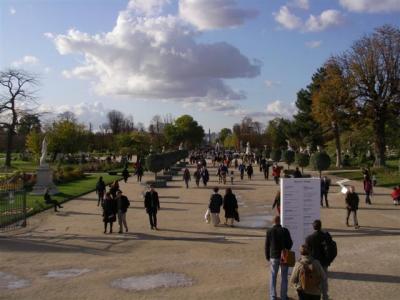
Back when the Louvre was the Royal Palace, the Carrousel was where the royalty practiced their horse riding skills and etiquette. The entrance to the Louvre is flanked by to the Arc de Triumph du Carrousel, a Roman style arch fairly similar to the Arc de Constantino in Rome. It is topped by a statue of someone standing on a chariot. Here is the Carrousel, the arch and some of the Louvre buildings.
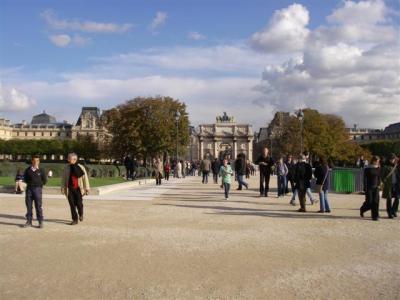
The Louvre was originally built in the 13th century as a fortress and was rebuilt in the 16th century as the residence of the royal family. Over the years, the Louvre complex kept growing as each successive king built another wing onto it. From what we can see, the Louvre looks huge, and our guide told us that a wing that had jutted out into the Carrousel had burned down and was never rebuilt. It is hard to believe it used to be bigger. The royal family lived there until the mid-1700’s, when Louis XIV decided to build himself a new palace in the town of Versailles, 21 km outside of Paris. During the French Revolution, the Louvre was seized and in 1793 turned into France’s first national museum.
On the north side of the garden and Louvre is a series of buildings designed by a German architect. When they were built, they were the first of their kind. In the mid 1800’s, Emperor Napoleon III decided the city was not functional as it was. He put Baron Haussmann in charge of creating a master plan for the city. Haussman used these buildings as a prototype for his new social stratification vision. 60% of the city was destroyed so new infrastructure could be laid down, including sewers and straight, wide streets. The old buildings were replaced with this new style. Haussmann wanted to build the city vertically, not horizontally, hence the 7 8 story structures. The bottom floor was shops and the next floor up was storage for the shops. The third floor up (second floor for non-Americans) was housing for the wealthy with high ceilings and iron balconies. Each floor up the apartments became less and less nice, with the top floors in the attic having low, slanted roofs and tiny windows as housing the lowest class of servants. The vision was that people of various social classes would all live within the same community, and social class would be determined by what floor you lived on, not what neighborhood you lived in. This is why so much of Paris is so similar in style and architecture.
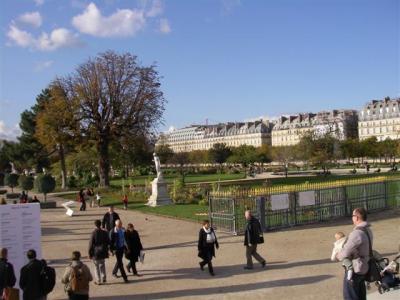
This was the end of the line for our tour. We headed back, this time riding on the opposite side of the river. We passed the National Assembly building, which is the French equivalent to the American House of Representatives. The rest of the route was the same.
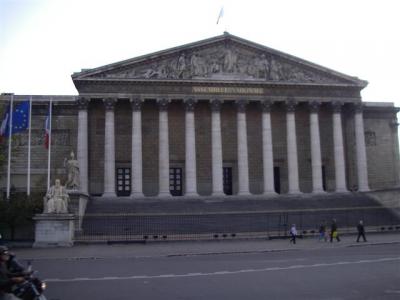
After the tour, we walked back to the Eiffel Tower. The tower was built in 1889 for the World Fair. It was designed by Gustav Eiffel, is 324 meters high, has 10,000 tons of iron and 2.5 million rivets. The Parisian elite were opposed to it, calling it a “metal asparagus”. It was almost torn down in 1909, but because it made a good radio tower, it was spared. During Hitler’s visit to Paris during the Nazi occupation, he wanted to go up to the top of the tower. Someone cut the elevator cables so he couldn’t. 5.8 million people a year visit the Eiffel Tower.
The lines were just as long as they had been earlier. We waited in line for a while to buy tickets, then had to get in another fairly long line to get on the elevator. The elevator is goes up a slant. If you look back at the photo of Eric in front of the Eiffel Tower, you will see that the four legs that comprise the base of the tower are both curved and angled, and the elevator is also angled to match. It’s kind of weird to be inside. The elevator takes you to first terrace, which is near Eric’s head if you look at the photo. Pretty much as soon as you get off, you queue up again for the next elevator, a normal straight elevator that takes you to the top. The view from the first level is beautiful. The view from the top is also great.
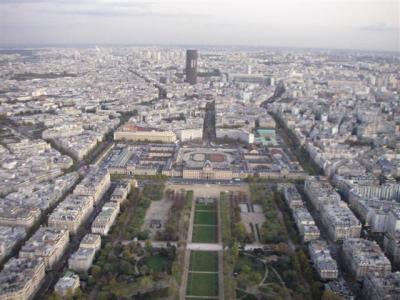
The top of the tower has an interior viewing area with displays showing the names of all the different buildings you are looking at, as well as an outdoor viewing platform. There is a tiny apartment that the designer made for himself up there to entertain guests. The structure itself is essentially just a metal frame, with not a lot to it other than the three viewing platforms. Our opinion is that it is definitely something everyone should do once, but because of the painfully long lines, we doubt we’d do it again.
The sun was just beginning to go down when we finally made it up to the top. We decided to hang out up there and watch the sun go down and the lights go on. We were frustrated to find out that the lines to get on the elevators going down are just as painfully long as the lines going up. And now that it was dark, it had gotten really cold.
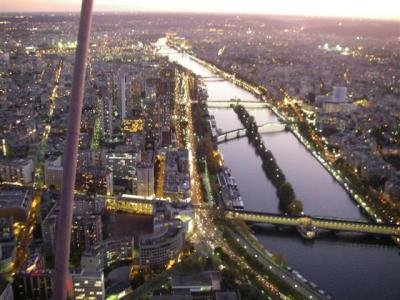
By time we got back down it was 1930. They light it up differently, this time it was EU theme.
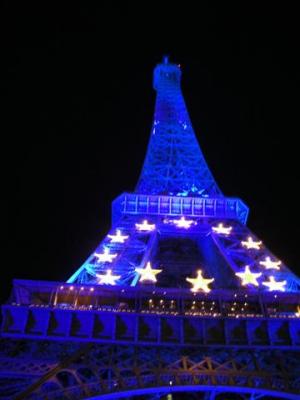
Should we have dinner first, which could easily take two or three hours, then go check into our hotel? We were worried they would give our room away if we checked in too late, so we decided to postpone dinner and check in first. We caught the subway to Bastille to pick up our luggage, then hopped back on the subway to the station closest to the hotel. We walked a few blocks, noting that the streets here are a lot quieter than in Bastille and Marias. We found the street the hotel was on, and turned left onto it.
Christi’s eyes widened with horror as we passed a nudie bar, sex shop, an adult video store, and a lady of the night before arriving at our hotel, located only a couple doors away from yet another sex shop. Christi was terrified to go in, imagining it to be dirty and gross, filled with druggies and hookers. As is the case with most of the hotels we have been to, the ground floor is only big enough to be a landing for a staircase and the lobby is one floor up. It didn’t bother us in any of the other hotels, but here it looked ominous. We walked up one flight of stairs. The stairs were lopsided and lumpy from being worn away in spots, which Christi took as a bad sign. Never mind that half the stairs in France are lumpy from being worn away, even in some of the nicest attractions in town. The reception area was basic utilitarian, a small room with a desk, white walls and cheap carpet. There was a folding chair with a portable TV sitting on it that was tuned in to sports. The only décor was quite a few interesting small metal sculptures displayed on shelves. The sculptures were mostly clocks, modern in style, and really cute. They were all definitely made by the same artist, who we assume probably owns the hotel.
We got our room key and nervously headed up. The room was totally clean. It was completely basic and utilitarian with zero frills, but clean and functional. The window sill even had cheerful fake flowers on the metal railing. Once we knew the hotel was OK, we felt better about the neighborhood. No one had bothered us in the street, we hadn’t seen any dodgy characters lurking about, and Lonely Planet hadn’t designated it a “bad” area. It was probably OK. Like getting a hotel room in Kearny Mesa (section of town in San Diego with lots of adult entertainment venues)
We went to dinner at a nice looking café near the metro station that we had seen earlier. Eric oddly ordered a hamburger, which came with a very pink hamburger patty topped with a runny over easy egg, but no bread, condiments, or other toppings. It did come with a salad, so you could have put lettuce and tomato from your salad on it, if you wanted. The food was pretty good.

Jarden de Tuileries was once the Tuileries Palace, royal and imperial seat of power. At one time it was connected to the Louvre. After surviving numerous revolts, the Terror and many restorations, it was burned down by the Commune in 1871 after the Prussians kicked the last French Emperor off his throne. The burnt down shell of the palace was torn down some time later and only the “garden” remains. You may be aware of the French and their love of dogs. If you had visited the Jarden de Tuileries you would have found the results of that passion– dog shit, all over the place. Another French trait, not picking up after their dogs. Very stinking place it was!
-rich
I can just imagine the look on christi’s face–thank goodness the hotel/room were safe in the end!
thanks for the tour